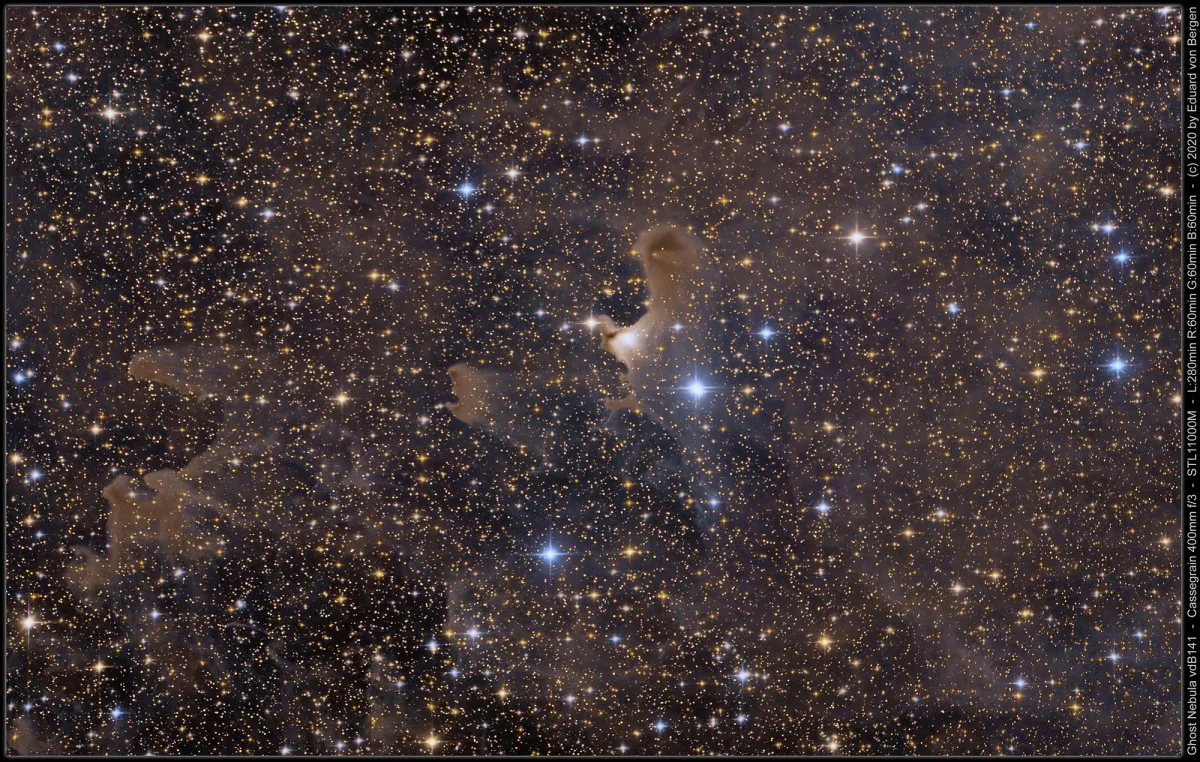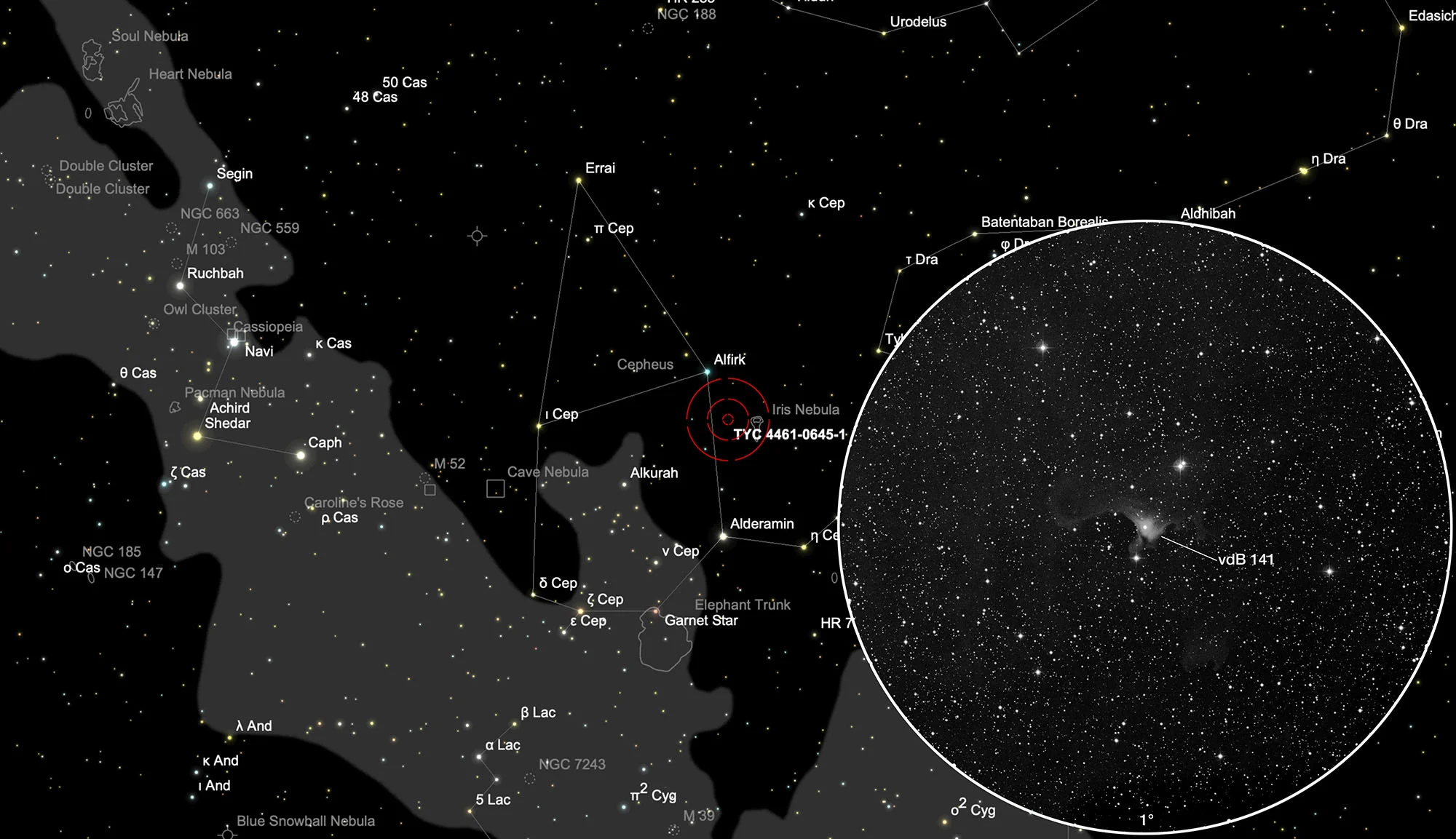Ghost Nebula (Sh 2-136, vdB 141)

History
While searching the photo plates of the «Palomar Observatory Sky Survey» made with the 48 inch Schmidt telescope, the American astronomer Stewart Sharpless came across the emission nebulae Sh 2-136 and published it in 1959 together with a total of 313 H-II Regions in a catalog. [310]
In 1962 Beverly T. Lynds published a compilation of 1802 nebula in her «Catalogue of Dark Nebulae» that she found on photo plates of the «National Geographic Palomar Observatory Sky Atlas». This nebula is listed there with the designation LDN 1177 (or L1177). [473]
In 1966 Sidney van den Bergh searched the «Palomar Sky Survey» photographic plates for reflection nebulae and found one (vdB 141) around the star BD+67 1300. He included it in his 1966 «Catalog of Reflection Nebulae» and classified the nebula as «Type I», which means the star illuminating the nebula is inside the nebula. He gave the brightness of the nebula on the blue photo plates with «F» (faint = weak), the colour with «R» for reddish and absorption «Wk» (weak = weak). [255]
Physical Properties

The star associated with the reflection nebula vdB 141 is BD+67 1300 (TYC 4461-645-1) and is of spectral type G8. Measurements published in 2018 by ESA's Gaia spacecraft, launched in 2013, revealed that it is 1120 light-years away and moving towards us at 32 km/s. But there are other stars inside this molecular cloud, because it is a star-forming region. The visual brightness is given as 9.4 mag in the vdB catalogue, but Simbad has a brightness in the V-band of 10.8 mag. [145, 255] The nebula belongs to the molecular cloud CB 230 or LDN 1177, which belongs to a large complex of molecular clouds called «Cepheus Flare Region».
In Fig. 2 on the right you can see the jet of a young protostar within the molecular cloud. The photo gives an idea of why vdB 141 was nicknamed "Ghost Nebula". Two ghosts raise their arms menacingly. Other nicknames are: «Spooky Nebula» or «Ghosts of Cepheus». There are other nebulae that have received a similar nickname: Little Ghost Nebula (NGC 6369), Ghost Head Nebula (NGC 2080), Ghost of Cassiopeia (IC 63).
| Name | Type | RA (J2000.0) | Dec (J2000.0) | PM [mas/y] | Parall. [mas] | Rvel [km/s] | z | SP Type | Size ['] | Magnitudes | Identifiers |
|---|---|---|---|---|---|---|---|---|---|---|---|
| vdB 141 | * | 21h 16m 26s | +68° 15' 37" | 7.948 | 2.9313 | -32.11 | -0.000107 | G8 | B 12.1; V 10.8; G 10.303263; J 7.969; H 7.247; K 6.986 | 2MASS J21162632+6815366; BD+67 1300; GEN# +0.06701300; GSC 04461-00645; Gaia DR1 2222370079297770752; Gaia DR2 2222370083595582592; Gaia DR3 2222370083595582592; TIC 422431768; TYC 4461-645-1; UBV M 4827; VDB 141 | |
| Sh 2-136 | RNe | 21h 16m 26s | +68° 15' 36" | GN 21.15.8; SH 2-136; [RK68] 107 | |||||||
| LDN 1177 | DNe | 21h 17m 39s | +68° 17' 34" | 4 × 2 | 2MASS J21173862+6817340; 2MASX J21173843+6817340; IRAS 21169+6804; IRAS F21168+6804; LDN 1177; TGU H641 P1; TIC 422454710; [CB88] 230; [DB2002b] G105.18+13.16 |
Finder Chart
VdB 141 is located in the western part of the Cepheus constellation, not far from NGC 7023. The exact position in the eyepiece can be compared with the 1° closeup. Pay attention to the row of three with the distinctive double star in the middle, which shows the way to vdB 141. The constellation Cepheus is circumpolar, but it is highest in the sky in the months of April to January and the nebula can therefore be observed best then. On 10 August it is in opposition to the Sun and culminates at local midnight.
